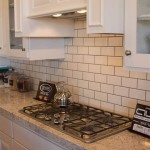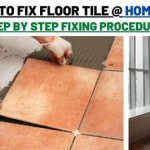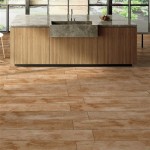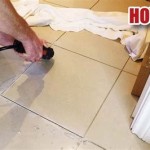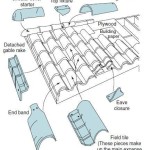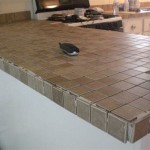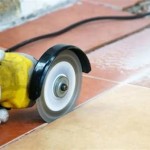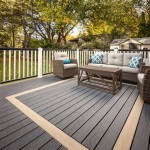Can You Put Ceramic Tile On Drywall In A Shower? A Comprehensive Guide
The question of whether ceramic tile can be directly installed onto drywall within a shower environment is a complex one, requiring a thorough understanding of building codes, material properties, and best practices. While technically possible in certain limited circumstances, it's generally not recommended and often outright prohibited. This article will explore the reasons behind this recommendation, outlining the potential problems, alternative materials, and proper installation techniques to ensure a waterproof and long-lasting shower enclosure.
Drywall, also known as gypsum board, is a common building material used for interior walls and ceilings. It consists of a gypsum core sandwiched between two layers of paper. Its primary advantage is ease of installation and relatively low cost. However, standard drywall is inherently porous and highly susceptible to moisture damage. When exposed to prolonged humidity or direct water contact, drywall can absorb moisture, leading to swelling, crumbling, and the growth of mold and mildew. These issues compromise the structural integrity of the wall and create an unhealthy environment.
Ceramic tile, on the other hand, is a durable and waterproof material when properly installed. Its resistance to water, stains, and wear makes it an ideal choice for shower walls and floors. However, the effectiveness of ceramic tile as a waterproofing barrier relies entirely on the substrate to which it is adhered. If the substrate fails due to moisture damage, the tile installation will inevitably fail as well.
Understanding the Risks: Why Drywall Fails in Showers
The primary concern with using drywall as a substrate for ceramic tile in a shower is its vulnerability to moisture penetration. Even with grout and sealant, water can seep through microscopic cracks and imperfections, eventually reaching the drywall behind the tile. This moisture infiltration can lead to several serious problems:
1. Drywall Degradation: As drywall absorbs moisture, the gypsum core begins to break down and lose its structural integrity. This weakens the bond between the drywall and the tile mortar, leading to loose tiles and eventual tile failure. Warping and crumbling of the drywall can also create an uneven surface, making it difficult to maintain a consistent grout line and potentially causing cracks in the tile itself.
2. Mold and Mildew Growth: The damp, dark environment behind the tile provides an ideal breeding ground for mold and mildew. These organisms not only damage the drywall but also pose significant health risks. Mold spores can trigger allergies, asthma, and other respiratory problems. Removing mold from behind tile often requires extensive demolition and remediation, adding significant cost and inconvenience.
3. Structural Damage: In severe cases, prolonged moisture exposure can extend beyond the drywall and affect the framing studs behind the shower wall. This can lead to wood rot and structural instability, requiring extensive repairs and potentially compromising the safety of the entire bathroom.
4. Grout and Sealant Failure: The constant expansion and contraction of the drywall due to moisture absorption and drying can put stress on the grout and sealant. This can cause cracks and gaps to form, further accelerating water penetration and exacerbating the problems described above.
While water-resistant drywall, often green or blue in color, is sometimes considered as an option, it offers only limited protection. Water-resistant drywall is designed to withstand occasional splashes and spills, not the constant exposure to moisture associated with a shower environment. The paper facing, even with water-resistant additives, is still susceptible to moisture damage over time. Furthermore, any cuts, punctures, or nail holes in the water-resistant drywall compromise its protective layer, creating pathways for water to penetrate the core.
Building codes, while varying by locality, generally discourage or prohibit the use of standard drywall in shower enclosures. Even when water-resistant drywall is permitted, it's often required to be used in conjunction with a waterproofing membrane to provide adequate protection.
Superior Alternatives to Drywall in Shower Enclosures
Given the inherent limitations of drywall in shower environments, several alternative materials offer superior performance and longevity:
1. Cement Board: Cement board, such as HardieBacker or Durock, is a water-resistant substrate specifically designed for use in wet areas. It is made from cement, reinforced with fiberglass mesh, and is highly resistant to moisture damage, mold growth, and degradation. Cement board provides a stable and durable surface for tile installation, ensuring a long-lasting and waterproof shower enclosure.
When installing cement board, it's crucial to follow the manufacturer's instructions carefully. This typically involves using corrosion-resistant screws to attach the board to the framing studs, leaving a small gap between sheets, and taping and mudding the seams with a cement-based compound. A waterproofing membrane is still recommended, even with cement board, to provide an additional layer of protection.
2. Waterproofing Membranes: These membranes, often liquid-applied or sheet-based, create a continuous waterproof barrier behind the tile, preventing moisture from reaching the substrate. Liquid-applied membranes, such as RedGard or Hydro Ban, are applied with a brush or roller and form a seamless waterproof layer. Sheet membranes, such as Schluter-KERDI, are thin, flexible sheets that are bonded to the substrate with thin-set mortar.
Waterproofing membranes are essential for ensuring a waterproof shower enclosure, regardless of the substrate used. They provide an extra layer of protection against moisture infiltration and help to prevent the problems associated with drywall failure.
3. Waterproofing Foam Boards: This option provides a lightweight, waterproof substrate that is easy to install. These boards are typically made from extruded polystyrene (XPS) or expanded polystyrene (EPS) and are coated with a cement-based surface. They offer excellent insulation properties in addition to waterproofing capabilities. An example of this type of substrate is Wedi Board.
4. Tiled Walls using a Waterproofing System: This system involves applying a waterproofing system directly to the framing studs and then tiling over it. This eliminates the need for a traditional substrate like cement board or drywall. These systems often include a combination of membranes, sealants, and specialized tapes to create a completely waterproof enclosure.
The selection of a suitable alternative depends on factors such as budget, skill level, and specific project requirements. Consulting with a qualified contractor or building professional is highly recommended to determine the best solution for a particular situation.
Proper Tile Installation Techniques for Shower Enclosures
Even with the correct substrate material, proper tile installation techniques are crucial for ensuring a waterproof and long-lasting shower enclosure:
1. Surface Preparation: The substrate must be clean, dry, and free of any loose debris or contaminants. Any imperfections or irregularities in the surface should be corrected before applying the mortar.
2. Mortar Selection: Use a high-quality modified thin-set mortar specifically designed for use with ceramic tile and in wet environments. Follow the manufacturer's instructions carefully for mixing and application. The mortar should be troweled onto the substrate using the correct size notched trowel to ensure proper coverage and bond strength.
3. Tile Placement: Press the tiles firmly into the mortar, ensuring full contact with the substrate. Use tile spacers to maintain consistent grout lines. Regularly check for level and plumb to ensure a professional-looking installation.
4. Grouting: Allow the mortar to cure completely before applying grout. Use a high-quality epoxy or cement-based grout specifically designed for wet environments. Epoxy grout offers superior stain resistance and water impermeability compared to cement-based grout. Follow the manufacturer's instructions for mixing and application. Ensure that the grout lines are completely filled and free of voids.
5. Sealing: After the grout has cured, apply a high-quality sealant to the grout lines and any seams or transitions. This will help to prevent water penetration and protect the grout from staining and discoloration. Reapply sealant periodically as needed to maintain its effectiveness.
6. Control Joints: Incorporate control joints in the tile installation to accommodate movement and expansion. These joints are typically filled with a flexible sealant and are strategically placed at corners, intersections, and along long runs of tile. Control joints help to prevent cracks and delamination caused by temperature and humidity fluctuations.
In summary, while technically possible to install ceramic tile directly on drywall in a shower, primarily with water-resistant options, it is generally ill-advised due to drywall's inherent susceptibility to moisture damage. Cement board, waterproofing membranes, and waterproof foam boards provide superior alternatives, ensuring a waterproof and long-lasting shower enclosure. Implementing correct tile installation techniques is essential for maximizing the effectiveness of any substrate and preventing future problems.

Tile Over Drywall Showers A Common But Bad Practice Scott Hall Remodeling
Can You Put A Ceramic Wall Tile On Sheetrock For Basement Shower Quora
What Happens If You Tile Over Drywall In A Shower Quora
Curb Wall Corner Drywall Transition Ceramic Tile Advice Forums John Bridge
Overlap Of Shower From Mud To Drywall Ceramic Tile Advice Forums John Bridge

How To Tile Over Existing Brepurposed
Trouble With Backerboard To Sheetrock Transition Ceramic Tile Advice Forums John Bridge
How Long Does It Take A Professional To Install Shower Tile Quora

What Type Of Drywall Board Is Needed To Tile A Shower Wall Doityourself Com

Can You Tile Over Drywall Master Building Materials Blog
Related Posts

